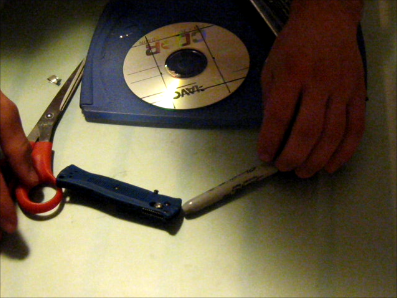Signaling for rescue is one of the most important, yet least-discussed aspects of wilderness survival preparedness. You have many options to choose from, including using mirrors, fire, smoke or carving messages into the sand. One simple and effective way to improvise a signal mirror is to use a CD and an Altoids tin. While it is very rudimentary, it can get the job done. Take a look at the the process below and see how putting this simple trick to use may end up saving your life one day.
Required Items
CD
Duct or electrical tape
Knife, scissors or utility razor
Ruler
Sharpie
Cutting Board
Altoids Tin
Fashioning the Mirror

The first step is to modify the CD so the mirror can fit inside of the Altoids tin when you’re finished. The easiest way to do this is to trace out the bottom of the tin on top of the center of the CD with the sharpie. You don’t want to use the top because the lip flares out and the mirror will be too big to insert later on.
Next, take your ruler and place it over the lines that you used to trace the tin. Extend these lines with the sharpie to the respective edges of the CD. This will make it easier to cut and trim the mirror. Place the ruler along the inside edge of the lines. This will account for the small difference in size between the inside and outside of the Altoids tin. The next step is to take your knife or razor and make a series of cuts along each line while you use the ruler as a guide. Make a few passes to create a groove that will make it easier to cut the disc in the next step. Repeat this process for the lines on all four sides.
You can now use the scissors to cut off the pieces, or you can continue to score the grooves with your utility knife. If you use the knife, make sure that you keep scoring until the grooves are deep enough to break easily when you place the line over the edge of a table or your cutting board. This will allow you to press down on the sides and cause them to snap right off.
Avoid trying to remove the pieces by scoring them for a couple of reasons. First, the razor can jam and cause it to slip, and this poses a safety hazard as you can accidentally get sliced. It can also crack the CD and force you to start all over again. The scissors work well, but you need to be careful that you are using a sharp pair and that the lines you cut are perfectly straight in order to fit into the tin. Using the edge of the table to snap the pieces off will give you a nice, clean break as long as the grooves are deep enough.
Once the pieces have been removed, consider using a file to smooth out any jagged edges and shape the corners to match the contours of the Altoids tin. This may or may not be necessary, depending on how small the piece is, but be prepared to do so in order to ensure a nice fit.

All you need to do now is add a thin layer of tape around the top and bottom edges of the mirror. This will help to keep the reflective coating from peeling away. The tape will also help to secure the mirror in place on the bottom of the tin. Cover the mirror with a thin piece of fabric or cardboard in order to protect it from any items that you may place on top. You can also add another piece of tape across the inner-edge of a border on one side of the mirror and secure it to the side wall of the tin. This will make it easier to pull up and angle the mirror for signaling if and when you need to put this device to use in the field.
Remember, that some of the best survival resources come from simple solutions and basic materials. While this mirror is definitely rudimentary, it can be just what you need to attract attention and get out of your survival situation alive.
